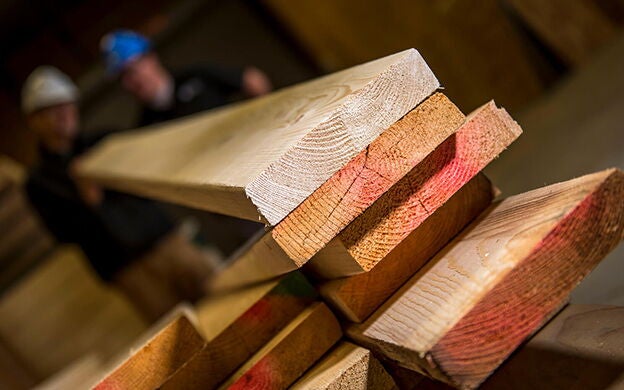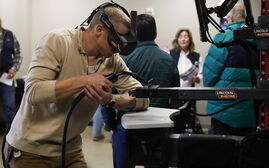How a new wood certified for construction could spruce up the economy
 Courtesy / UMaine Composites Center
The American Lumber Standards Committee has approved Norway spruce for use as construction-grade dimensional lumber. Faculty, staff and students at the University of Maine Advanced Structures and Composites Center tested lumber milled from the species.
Courtesy / UMaine Composites Center
The American Lumber Standards Committee has approved Norway spruce for use as construction-grade dimensional lumber. Faculty, staff and students at the University of Maine Advanced Structures and Composites Center tested lumber milled from the species.
For the first time in nearly a century, a new species of wood has been approved as construction-grade, in a development that staff at the UMaine Composites Center claims will have an immediate and direct impact on the economy of the state and region.
“This is a momentous occasion for the building industry,” Jeff Easterling, president of the Northeastern Lumber Manufacturers Association, said in a news release. “The addition of a new species hasn’t happened in almost a century, and it’s been a very exciting year as we’ve worked to shepherd it through testing and bring it into the mainstream.”
While native spruce has been used in construction, UMaine spokeswoman Beth Staples told Mainebiz in a phone interview Tuesday morning, Norway spruce isn’t native to the state and has not been used for building here, though it has been used in Europe. It has now been certified for construction, as trees planted during the Great Depression have reached maturity and are suitable for building, according to the university’s studies.
The certification is the culmination of nearly five months of work at UMaine, where a team of staff and students at the Composites Center, led by Russell Edgar, wood composites manager, and Jon Hill, wood composites technician, tested 1,320 pieces of lumber milled from Norway spruce grown in Maine, Vermont, four regions of New York and Wisconsin.
Based on that extensive testing, the American Lumber Standards Committee approved the inclusion of Norway spruce in the Spruce-Pine-Fir South grouping of wood species for home construction and industrial applications on Oct. 20.
“It is exciting to be involved in this type of research, which has immediate and direct economic impacts for the state and region. This is exactly why our center exists,” Edgar said in a statement.
A press conference about the potential economic impact of the new wood to the state will be held Wednesday at the university.













Comments